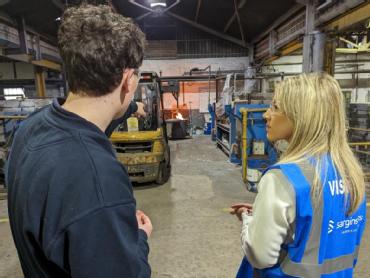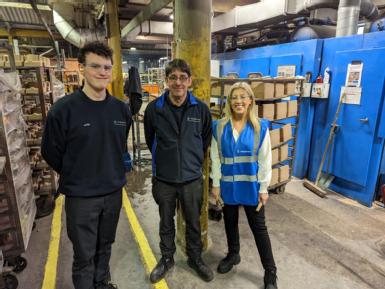Success Story
Waste streams to wins - Midlands foundry uncovers potential to reduce core shop waste by 50%
“Circular manufacturing is an essential step in the journey to Net Zero and the work carried out by WMG was the first step in what has become the primary focus of Sarginsons’ strategy: to be the first foundry in the world to have a totally circular supply chain.”
Mark Nunan, Director, Sarginsons Industries Ltd
Challenge – How to minimise waste and reduce emissions
Coventry based SarginsonsLink opens in a new window are a leading European aluminium foundry that design and produce complex aluminium castings for light weighting in the automotive sector as well as for rail, oil and gas, and wind energy applications. Currently working with WMG on a suite of different projects including an internship to look at optimal melting processesLink opens in a new window and a project to recover heat from their industrial processesLink opens in a new window, they were keen to explore how they could minimise waste and carbon emissions in the business. They needed help to work out why only 53% of the 280 tonnes of silica sand they purchased each year was contributing to the production of usable cores[1] and why the rest was not being utilised. Any sand not used went to landfill. This was a huge material loss stream for them.

Solution - Collaboration is key to understanding
Sarginsons signed up to a WMG Net Zero Innovation cohort which is designed specifically to help manufacturers decrease carbon emissions in the business, while saving costs and identifying new opportunities. It involved joining a group of other likeminded manufacturers including Summit Patternmaking, Impression Technologies, and KS Composites to share ideas and challenges on their individual Net Zero journeys.
After a series of collaborative workshops with expert speakers and a Net Zero Readiness Assessment to benchmark their current Net Zero position across the business, they were ready to make a start on the waste reduction project within their onsite core shop.
WMG's Laura DowneyLink opens in a new window first set about helping Sarginsons better understand their material utilisation. It involved measuring and mapping the process from silo to finished core. It was discovered that 133 tonnes of silica sand per year were not being utilised, costing the business over £18,000. Laura also identified the wasted energy costs involved in this process which was around 15000kWh/ £2000.
Laura then went on to make recommendations for how Sarginsons could reduce this waste using the 6R Waste Hierarchy model. Ideas included using digital solutions to monitor equipment, predict and preventative maintenance, and engaging employees to minimise waste more effectively. She suggested that unavoidable waste sand and post processes sand could be used to create construction materials and also presented a business opportunity to reuse and reclaim sand onsite or work with other casting firms to do this collaboratively offsite. As well as saving on the land fill taxes and cost of buying virgin silica sand, thermally reclaimed sand has been shown to provide improvements in casting quality and if used can reduce the need for adding binder to achieve acceptable strengths.

Results - The road to less environmental impact
- By implementing these recommendations, Sarginsons have the potential to boost their environmental credentials which is hugely important as part of their role on the Coventry City Climate Change Board and with their customers and supply chain.
- A 50% reduction in waste in the core shop process will result in significant cost and energy savings and 2.6 tonnes in Co2 equivalent.
“You can’t manage what you don’t measure. Working with Sarginsons to map their waste streams and measure the material utilisation of their core shop highlighted waste hotspots that open the door to exciting opportunities to develop a more circular way of operating.”
Laura Downey, Innovation Manager, WMG
[1] Core making is the process which forms the interior part of a casting. The mold provides a space for the molten metal to go, while the core keeps the metal from filling the entire space.
For more information about WMG's Net Zero Innovation Programme click here


